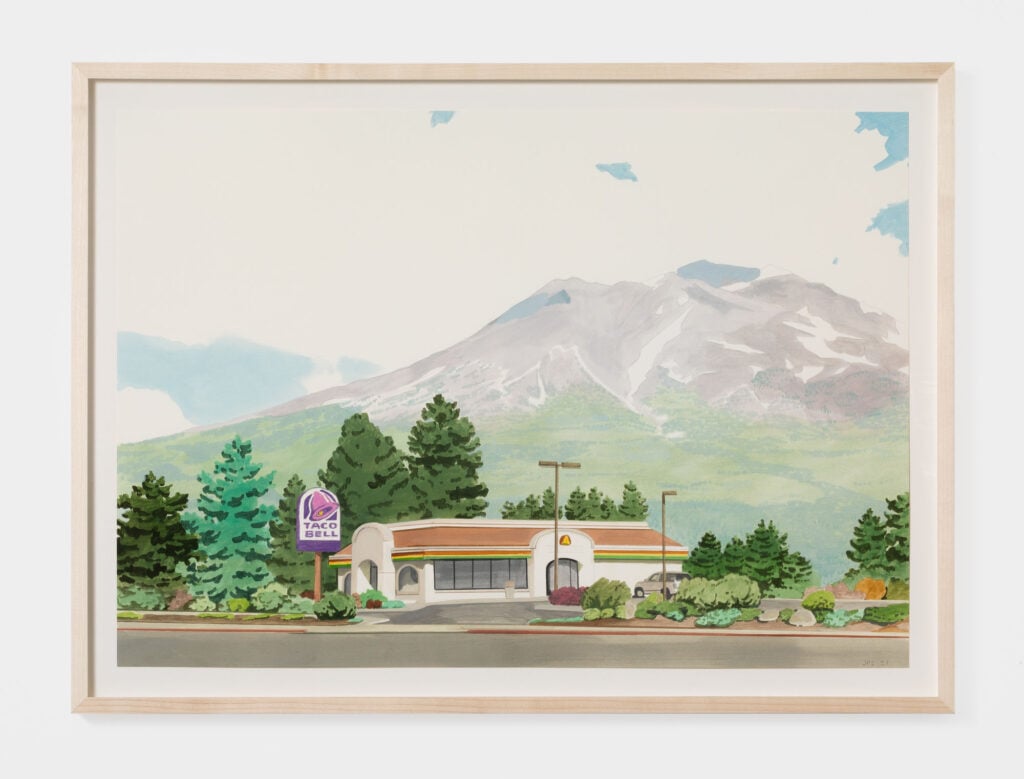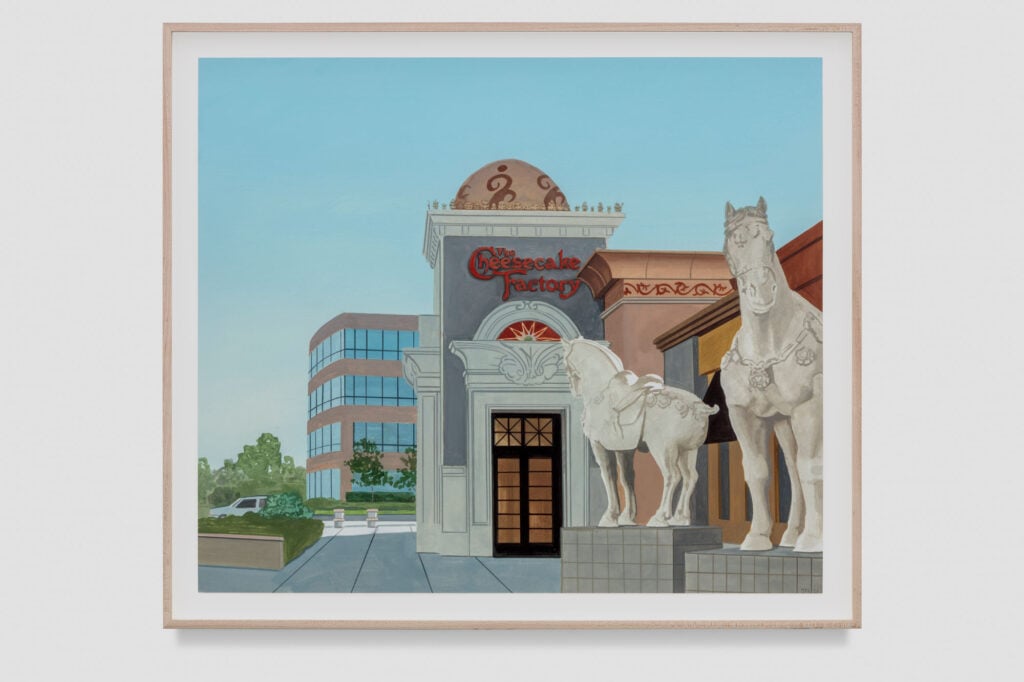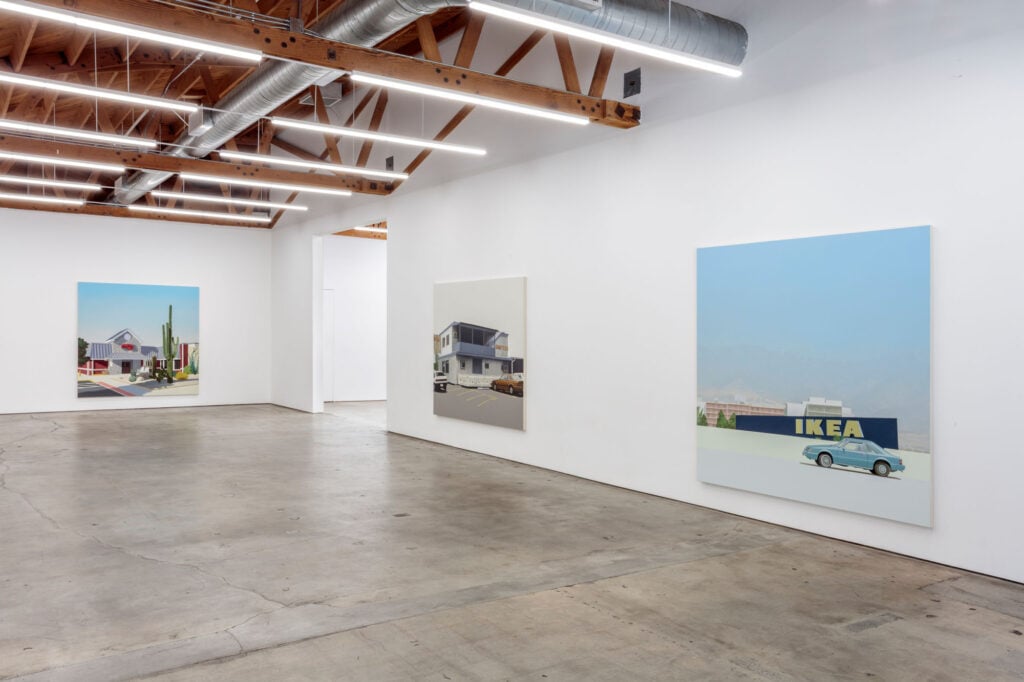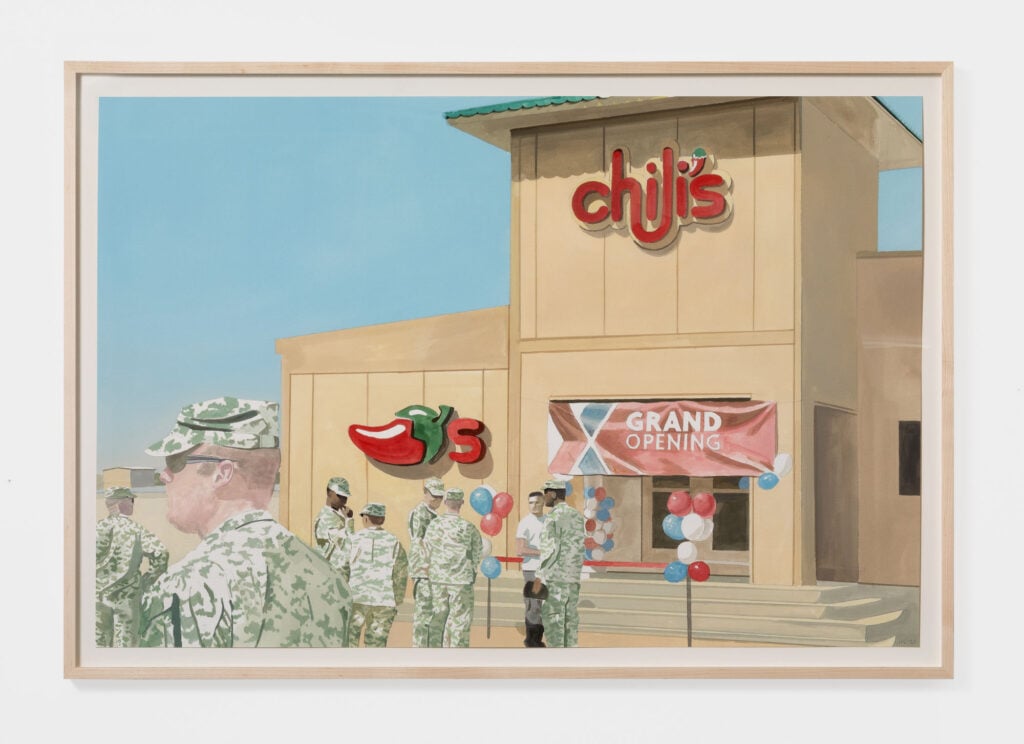
October 27, 2021

Ethan Tucker: The paintings in Seasonal Concepts are all depict the kinds of buildings you might find along a suburban commercial strip. What interests you about these buildings?
Jake Longstreth: This show is all national corporate retail and restaurant chains—big publicly traded companies that you might encounter off any freeway whether it’s Texas, Virginia, California, or Minnesota. I just got interested in that strictly because of the ubiquity. Some of these chains go way back to the 1950s, but growing up, I started to notice them, and I noticed the saturation increasing as the years went by. I thought these things were so characteristic of our time. They were so big, too. It’s like, where do I stand to shoot all these source photos? It seemed very tricky. And I just thought they were potent and amusing symbols to take as subjects.
ET: They really are. Do you feel that there’s an archival quality to your work? Like you’re recording what is out there and what it looks like?
JL: Absolutely. I think of when you look back at old photographs of the 1920s, ’50s, or ’70s, I want my paintings to have the patina of our era. Their meaning will change as time goes by. We’re not nostalgic at all for Circuit City, which went out of business in 2009, but eventually we might be. Especially as things continue to change and there’s less retail on the street. And these corporate, cookie-cutter places that we don’t have any sort of emotional bond to whatsoever, we might look back and feel differently. How strange is that?
ET: Right. There’s a sort of a placelessness to these paintings because they’re of these enormous chains that are all over the country. But you title some of them with place names. There seems to be a tension there between atopia and rootedness.

JL: Generally, I like that tension of these completely placeless, generic, cookie-cutter, corporate retailers, but I do like to infer that it is specific to SoCal. Sometimes there’s the dusty Chaparral-studded hillside, or a smoggy sky, or there are oleanders or palm trees, or something that sort of hints at California. Plus, California is like the granddaddy of the strip mall archetype. These aren’t really strip malls, but they are like the logical end point of strip malls.
My default mood for the painting and atmosphere: It’s 92 degrees out, July, and you’re in a Home Depot parking lot in Southern California. That’s the vibe.
ET: When you’re scouting out places to paint, do you just drive around the L.A. suburbs? Or do they come to you when you’re traveling?
JL: Yeah, I never know where I’m going to stumble across the right picture. It’s not like I go to any old Home Depot and just shoot a picture of the sign and that’s the painting. I have to search high and low for the right vantage point and a lot of times, it’s not there. Or there are too many cars or trees in the way. I can make things up and move things around to some degree, but I have spent a lot of time in the car. Sometimes I’m just driving somewhere with people and see something that’s great. Then I pull over and shoot it.
ET: Is there a particular drama that you’re looking for?
JL: Like a stately kind of elegance or something. Because if you just Google image search Cheesecake Factory, the pictures are going to be bad. It’s chaos. The pictures suck. They’re taken too close to the building so all of the parallel lines of the architecture are converging. Or it’s fish-eyed. There’s just no elegance or poetry.

ET: Is there a certain chain or type of building that you are drawn to as a subject?
JL: The Cheesecake Factory is one brand I wanted to tackle with this show. There’s two works on paper of two different Cheesecake Factories, both of which are based on things I’ve found and then played around with in Photoshop. The architecture is so funny. What [style] are they going for? Is it like Islamic? You know what I mean? There’s like weird spires. It’s a wild, wild chain.
And that’s hard to photograph too because usually they’re directly adjacent to other buildings, so then it’s really hard to get any sense of space because it’s just so dense. There’s a painting I did of a Cheesecake Factory that’s nestled right next to a P.F. Chang’s. The P.F. Chang’s has those huge concrete horses out front. That’s just a wild painting.
ET: Most people, it seems like even you to a certain extent, think of these chain stores as ugly, wacky buildings that you don’t necessarily want to spend time in or around, but have found a way to reframe them. Can you comment on that?
JL: When I first started doing this work years ago, I felt like I needed to have a thesis statement and maybe have it be sort of political, like ‘Corporate America sucks and they’re ruining the country’. But I ultimately backed away from that sort of framing because I’m not researching and writing books about corporate retail. I’m much more interested in the appearance of things. It is loaded subject matter, but I definitely want to leave the paintings open to interpretation.

Would you like to comment on this article? Send your thoughts to: [email protected]
"Factory" - Google News
October 28, 2021 at 01:33AM
https://ift.tt/3bfWH2T
From Circuit City to the Cheesecake Factory, Jake Longstreth Paints Suburbia - Metropolis Magazine
"Factory" - Google News
https://ift.tt/2TEEPHn
Shoes Man Tutorial
Pos News Update
Meme Update
Korean Entertainment News
Japan News Update
Bagikan Berita Ini














0 Response to "From Circuit City to the Cheesecake Factory, Jake Longstreth Paints Suburbia - Metropolis Magazine"
Post a Comment